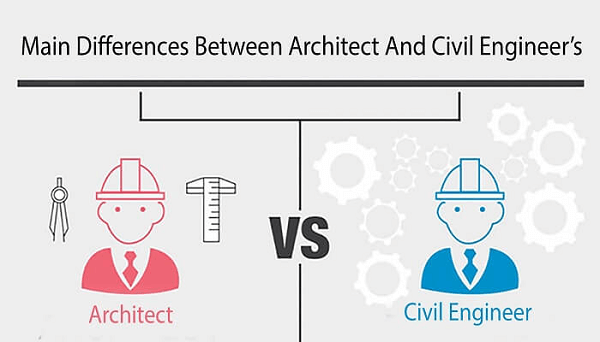Difference Between Architecture and Civil EngineerBuilding and structural design is a collaborative effort of civil engineer and architecture. Architecture is more concerned with the design's artistry, appearance, feel, and usefulness and places a greater emphasis on the spatial functioning and aesthetics of the development process. What distinguishes civil engineer from architecture? The focus of civil engineer is on the construction of the innovation, ensuring that it can withstand both normal and abnormal situations. See out here how civil engineer and architecture vary from one another. Architecture and Civil Engineer - An ExplanationYou may already be aware of how buildings, mansions, and other towers are designed and built, and you may be certain that experts like architects and civil engineers are needed to complete the task. The "connection between architecture and civil engineer " is one of complementarity, wherein a building or structure's design and planning by architects are supported by civil engineers' technical and practical know-how in its creation and upkeep. 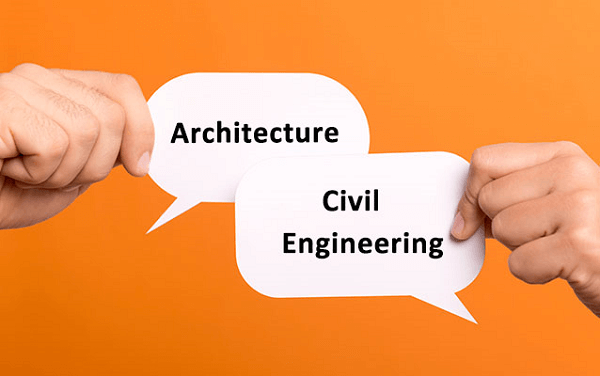
Here, we compared and contrasted civil engineer and architecture in terms of definition, application, and key differences. Let us know them Briefly ArchitectA person or organization that has been registered, granted a license, or received some authorization allowing them to practice architecture in a province or territory. 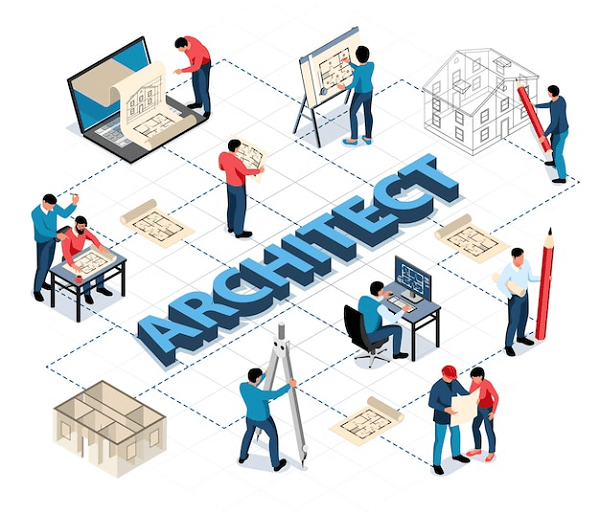
A professional who is trained to create constructed items in our public and private landscapes and offer to advise on them, both aesthetically and technically, is the most fundamental description of an architect. However, the function of an architect is hardly covered by this description. Architects act as trusted consultants; their function is comprehensive, fusing several specifications and disciplines creatively while serving the public good and taking care of health and safety issues. Qualities of a Skilled ArchitectIt isn't easy to become a licensed architect. Although it is a great decision for a job, getting there requires a lot of effort, grit, and perseverance. It's great to work as an architect since you get paid well and have a ton of opportunities to work with different businesses and learn new things. 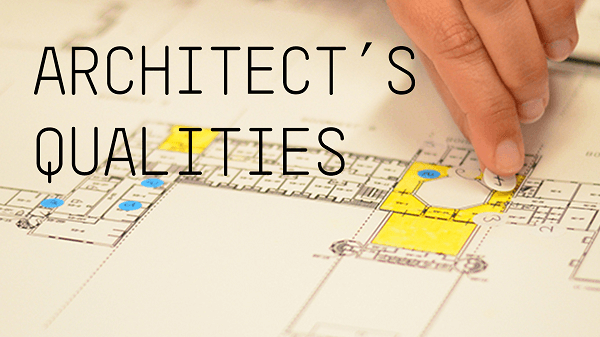
In a nutshell, being a professional architect in today's world means making your own significant and long-lasting contribution to the world's architecture and assisting in shaping entire communities and societies. It entails a great deal of responsibility, and only some are suited for this highly technical, diverse, and sophisticated position. Architects must have a certain combination of attributes and talents in order to be viable contenders for such a fantastic job. Let's go deeper into some of the characteristics that will make you a professional architect and help you stand out from the competition. 1. Having a Solid Grasp of NumbersThe limitations and guidelines of mathematics form the foundation of the idea of contemporary architecture. Your chances of succeeding in your profession are much better if you are skilled with numbers. A skill highly valued in architecture is the ability to understand mathematical concepts, particularly complex algebra, and geometry. In many job interviews in the architectural sector, that is also a fundamental need. 2. CreativeCreative thinking is key in architecture. People must be extremely busy and innovative to succeed in it. You'll need to be innovative and creative, as modern architects are expected to create cutting-edge constructions that will push the bounds of aesthetics to a whole new level. Thinking beyond the box and coming up with innovative ideas and bold breakthroughs that will fundamentally alter the most widely held beliefs are the main components of creativity. Since it sets you apart from the competition, it is your most important mission statement. You'll be accepted favorably and remembered if you consistently innovate. 3. Flawless Design AbilitiesA trait you must have if you want to work in architecture is incredible design talent. Several beginners make the error of believing that producing something beautiful requires no labor at all. You'll need to create both functional and visually pleasing constructions in addition to being viable. The wants and requirements of your clients must be met, but there are more crucial needs. This can only be done by developing a thorough knowledge of design processes. You'll find it easier to combine aesthetic appeal and utility without compromising. A skilled expert can compromise, but a smart architect understands how to blend these components. 4. Effective CommunicationCommunication is the most crucial trait for an architect, above and beyond fundamental knowledge, design abilities, and creativity. To accomplish their goals, architects must collaborate with a wide range of professionals from many sectors. You'll need to communicate with structural engineers, tradespeople, local government representatives, contractors, surveyors, construction managers, and attorneys as you navigate the complicated structure creation process. Their individual interests and worries are their own. Making excellent communication happen is crucial in this kind of setting. A project can only be effectively completed if everyone is working from the same blueprint. 5. TeamworkOne of the most essential traits of a qualified architect is teamwork, which is just behind communication. You must learn to work well with others since cooperation is something you must do on a regular basis. Using it as a key tool in your architectural arsenal would be best. Although you'll eventually need to collaborate with others, you can finish the design by yourself. You rely on the internal team to find new clients or receive updates on a project that is already underway. The construction team is who you hear from about material costs and if your design concepts are being followed. The client, who aids in determining the project's course and its useful functionality. Planning authorities and surveyors are important because they ensure that the work is done in accordance with the law and assist in safeguarding the local environment. And they are only the very beginning. It will be necessary for you to collaborate with people from various backgrounds and professions. A professional architect's ability to collaborate with others to achieve shared objectives is a highly desired trait. 6. Resolution of IssuesIssues sometimes arise when you least anticipate them, but a professional is always equipped to face whatever may arise. It is inevitable that there may be a few issues once huge projects are completed. You must be adaptive and flexible if a problem is directly tied to design in order to prevent further escalation, which will aid in effectively and rapidly fixing problems. Always be ready to suggest a different course of action, whether the problem is one of material availability, legislative enforcement, or something else completely. What does an Architect do?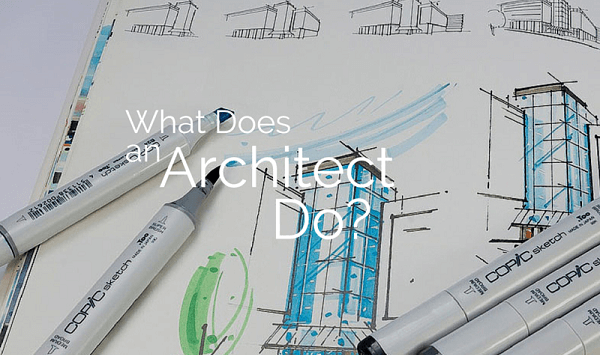
Here are the main duties of an architect:
Civil EngineerThanks to scientific concepts, humans can develop, build, and maintain bridges, roads, homes, residential structures, canals, and dams. 
To put it another way, the buildings that the architect has drawn out are designed by civil engineers. These constructions acquire form, strength, and endurance with the aid of civil engineers. An engineer designs a building to be able to handle the load, whether it comes from vibrations, external loads, or self-weight. In the field of engineering, a civil engineer would deal with anything non-military. Because of this, the field of a civil engineer is exceedingly broad. If you take a minute to reflect on your daily activities, you will see that every second of them is either directly or indirectly related to a civil engineer. Characteristics of a Professional Civil Engineer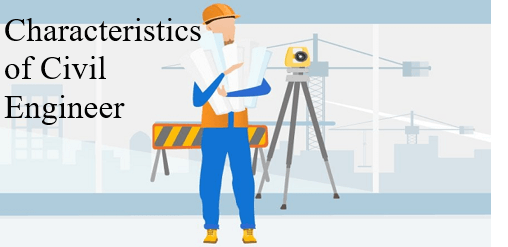
1. Flexible Thinking and CreativeThe creative part of engineers' ideas should not suffer just because they are recognized for working within limitations. Using engineering concepts to create solutions in a constructed setting takes a certain amount of imagination. When faced with constraints like customer demands, natural laws, and regional regulations, civil engineers are adept at coming up with beautiful solutions. 2. Communication SkillsEffective communication is essential for civil engineers; there should be no opportunity for ambiguity or misinterpretation. Engineering is a technical field with intricate systems, convoluted ideas, and lofty jargon. Civil engineers must be able to communicate concepts properly to various audiences, including regular people and other engineers and scientists. Also, civil engineers need to be able to listen and consider other people's opinions. 3. Technical KnowledgeA skilled civil engineer has strong math and physics skills when recognizing and resolving engineering challenges. Moreover, civil engineers receive training to develop their design skills and proficiency with models, drawings, and maps. It takes more than basic expertise in computer-aided design tools. They must be able to anticipate difficulties that may arise in the future and devise solutions for them. 4. Project ManagementIt is common for those working in a project to seek the engineer for direction and solutions when issues emerge. The ability to handle the job and lead a broad team of experts is essential for civil engineers. Also, civil engineers must assess the work of others and make sure it complies with all relevant standards, rules, and regulations. 5. Thinking CriticallyFinding effective solutions to complicated challenges is a common task for civil engineers. Nearly every activity needs to be tackled with an analytical mindset because engineering is a career that involves addressing a lot of problems. The answer must be exact enough to fulfill all standards while posing the fewest dangers possible during construction. While making wise financial judgments, civil engineers must be firm and astute. What does a Civil Engineer do?Here are the main duties of a civil engineer: 
Key Differences Between Civil Engineers and Architects
What Separates an Architect from a Civil EngineerThese are some things where an architect and a civil engineer vary from one another: 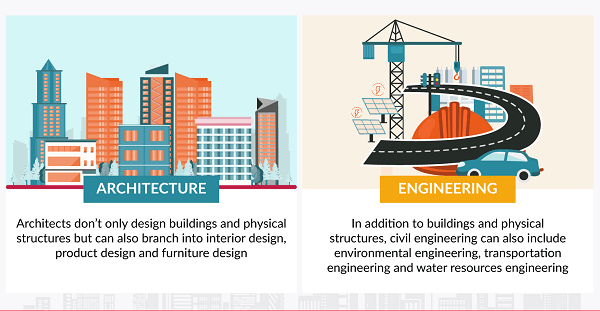
1. Basic DifferenceMost of the structures we see around us are the creation of an architect or a civil engineer. All around us, there are examples of contemporary wonders that civil engineers and architects have worked together to create, whether they are distinctive structures like skyscrapers or fundamental utilities like drainage systems. The fundamental distinction here is that civil engineers provide the framework to incorporate more analytical and quantitative components to these ideas. At the same time, architects envision the concepts and apply their creativity to maximize the available space. In addition, civil engineers play a vital role in developing various transport systems, including a railway networks, metro rail networks, new automobile models, and many other gadgets. 2. SalaryEmployment prospects and compensation are one of the main differences between the two professions. Generally speaking, architects find employment in a variety of architectural businesses, town planning firms, riverfront development projects, government planning projects, etc. Contrarily, the area of civil engineer encompasses a greater range of tasks. In addition to being engaged by the Indian Army, Navy, and Air Force, civil engineers are employed by private government organizations. They are assigned positions like a structural engineer, field engineer, site engineer, environmental engineer, geotechnical engineers, surveyors, etc. A Civil Engineer with little experience may expect to earn an average salary of 3 lahks per year; with appropriate experience, this can rise to 12 lahks per year. A starting architect may receive a package valued between 3.5 and 5 lahks per year. After attaining the necessary level of expertise, this might go to as much as 20 lahks each year. 3. Qualifications and CoursesA bachelor in architecture (B. Arch) degree, a five-year undergraduate program provided by several architectural institutes, is necessary for eligibility and to fulfill the prerequisite courses for becoming an architect. In contrast, a degree in civil engineer or a short-term certificate in civil engineer are the studies and qualifications required to become a civil engineer. For those seeking a degree in civil engineer, the B.Tech degree program provided by several engineering schools is a popular option. 4. Experienced AreasTwo professionals can work on the same project, but for a separate part of it depending on their areas of expertise. A professional architect's skill is to plan the building with spatial function in mind to give it a beautiful appearance and feel. The precise measurements used by civil engineers during construction ensure the longevity and integrity of the building or infrastructure needed. 5. Areas of FocusThe focus of an architect is on the shape, color, and spaces of the building, as opposed to the development work done by civil engineers. Their main concern is the construction project's visual attractiveness. The main job of the civil engineer is to choose appropriate materials and suggest changes to the architects' concepts. They place a lot of focus on structural elements and their examination. 6. Areas of ResponsibilityThe architect's responsibility is to create the plan for construction projects. The safe and reliable execution of the architect's design and management of the whole construction process is the responsibility of civil engineers. The interiors of rooms and offices are occasionally worked on by architects, who mostly focus on homes and businesses. A civil engineer is capable of working on many different projects, such as the construction of buildings, businesses, roads, and bridges. Tabular Difference
ConclusionWe have made an effort to present a thorough comparison between civil engineer and architecture. Just a person sketching on enormous sheets of paper comes to mind when you think of an architect. When you think of a civil engineer, you probably picture a person wearing a hard hat inspecting a building site and shouting orders to others engaged in assembly. Despite being clich�d, you are somewhat correct if you were thinking along these lines. Architects create entire structures, whereas civil engineers create a building's structural systems. Moreover, civil engineers can pursue various specialties. Thus, if you properly study it, this essay accurately describes the distinctions between architects and civil engineers. While there may be situations when the work of civil engineers and architects overlaps, a solid working relationship between the two professions will increase the efficiency and success of the building project.
Next TopicDifference between
|
 For Videos Join Our Youtube Channel: Join Now
For Videos Join Our Youtube Channel: Join Now
Feedback
- Send your Feedback to [email protected]
Help Others, Please Share





